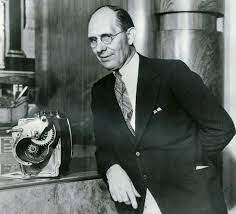 I am again in debt to Wikipedia for the information that follows. How fortunate we all are to have this invaluable resource. Please support it generously.
I am again in debt to Wikipedia for the information that follows. How fortunate we all are to have this invaluable resource. Please support it generously.
Charles Franklin Kettering (August 29, 1876 – November 25, 1958) sometimes known as Charles Fredrick Kettering was an American inventor, engineer, businessman, and the holder of 186 patents. He was a founder of Delco, and was head of research at General Motors from 1920 to 1947. Among his most widely used automotive developments were the electrical starting motor and leaded gasoline. In association with the DuPont Chemical Company, he was also responsible for the invention of Freon refrigerant for refrigeration and air conditioning systems. At DuPont he also was responsible for the development of Duco lacquers and enamels, the first practical colored paints for mass-produced automobiles. While working with the Dayton-Wright Company he developed the “Bug” aerial torpedo, considered the world’s first aerial missile. He led the advancement of practical, lightweight two-stroke diesel engines, revolutionizing the locomotive and heavy equipment industries. In 1927, he founded the Kettering Foundation, a non-partisan research foundation, and was featured on the cover of Time magazine in January 1933.
* * *
Kettering held 186 U.S. patents. He invented the all-electric starting, ignition, and lighting system for automobiles. Electric starters replaced crank (manual) starting of automobiles. First incorporated in the 1912 Cadillac, all-electric starting aided in the growth of the US auto industry by making the automobile easy for anyone to start. Other patents included a portable lighting system and an incubator for premature infants. His engine-driven generator was combined with storage batteries to form a “Delco Plant”, providing an electrical power for farmsteads and other locations far from the electrical power grid.
In 1918 Kettering designed the “aerial torpedo”, nicknamed the Kettering Bug. The 300 lb (136 kg) papier-mache missile had 12 foot (3.6 m) cardboard wings, and a 40 hp (30 kW) engine. It could carry 300 lbs (136 kg) of high explosives at 50 mph (80 km/h), and cost $400. The “Bug” is considered the first aerial missile, and lessons learned from the “Bug” led to development of the first guided missiles, as well as radio-controlled drones.
Kettering and colleagues’ development of leaded gasoline ultimately caused the release of large quantities of lead into the atmosphere as a result of the combustion of leaded gasoline all over the world. Due to the neurotoxic effects of lead, leaded gasoline has been widely banned since the late 1990s. The development of Freon using CFCs has been implicated in the depletion of the ozone layer.
He developed the idea of Duco paint and helped develop diesel engines and ways to harness solar energy. He was a pioneer in the application of magnetism to medical diagnostic techniques.
His inventions, especially the electric automobile starter, made him wealthy. In 1945, he helped found what became the Memorial Sloan Kettering Cancer Center, based on the premise that American industrial research techniques could be applied to cancer research. His son and daughter-in-law, Eugene and Virginia, created Kettering Medical Center in Ohio, as a tribute to Charles Kettering’s life and his work in healthcare research.
On January 1, 1998, the former General Motors Institute changed its name to Kettering University to honor Kettering as a founder.
* * *
Here’s my favorite Kettering quote: “If you’ve always done it that way, it’s probably wrong.”
To learn more about him, please click here.